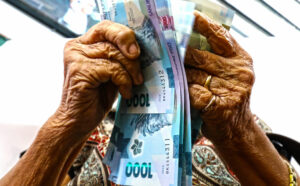By Luisa Maria Jacinta C. Jocson, Reporter
THE PROLONGED weakness of the Philippine peso could potentially fan inflation, but the central bank does not need to intervene unless the currency significantly drops, analysts said.
“Peso weakness becomes worrisome if, for instance, over a period of one year, the peso depreciates by P5, or to P63,” GlobalSource Partners country analyst Diwa C. Guinigundo said in a Viber message.
“This could potentially give rise to an additional 0.4 ppt (percentage point) or if the risk-adjusted inflation forecast of the peso is now at 4%, we might be looking at 4.4%.”
The peso closed at P57.84 against the dollar on Tuesday, strengthening by two centavos from its P57.86 finish on Monday. Its finish on Monday was its lowest in 18 months or since the P58.19-per-dollar close on Nov. 10, 2022.
The Bangko Sentral ng Pilipinas (BSP) does not need to intervene immediately unless the local currency drops sharply, Mr. Guinigundo said.
“Unless the peso shows sharp, disorderly fluctuations or some speculation persists, I don’t think the BSP will immediately go into active play in the foreign exchange market. Not worth losing its ammunition,” he said.
Ruben Carlo O. Asuncion, chief economist at Union Bank of the Philippines, Inc. said that the BSP may need to act if the peso further depreciates.
“I think that the BSP has established that their line-in-the-sand is the P58 level. I think they will intervene further with the US dollar-peso rate further weakening,” he said in a Viber message.
“However, I think that the market is being cautious but positioning with the release of US inflation data this week that may give further clues on how the Fed will proceed with its rate cuts,” he added.
BSP Governor Eli M. Remolona, Jr. earlier said that the central bank has only intervened in the foreign exchange market in “small amounts” to “maintain orderly markets.”
The BSP previously intervened in the foreign exchange market when the peso reached a record low of P59 against the dollar in October 2022.
Meanwhile, Mr. Guinigundo noted that the recent depreciation so far “may not necessarily translate into higher inflation” for the rest of the year.
“Short-term exchange rate pass-through for every P1 depreciation now stands at .08 percentage point additional inflation,” he added.
Inflation accelerated for a third straight month to 3.8% in April but marked the fifth straight month that inflation fell within the 2-4% target range.
However, Mr. Guinigundo said the peso would only sink drastically amid conditions such as a “significant reduction in economic growth, sharp increase in fiscal deficit and public debt, and huge increase in the balance of payments deficit.”
The Philippines’ gross domestic product (GDP) grew by a weaker-than-expected 5.7% in the first quarter, faster than 5.5% in the previous quarter but slower than 6.4% a year ago.
The National Government’s (NG) debt as a share of GDP stood at 60.2% as of the first quarter, below the 61.1% a year earlier and the 60.3% target set this year.
Meanwhile, the deficit-to-GDP ratio stood at 4.46% at end-March, easing from 4.82% a year ago and below the 5.6% deficit ceiling this year.
“If the market perceives the government not to be doing anything to address the huge imports of rice and other commodities, or stop smuggling and corruption, or improve governance in general, then that could cumulatively trigger a substantial weakening of the peso,” Mr. Guinigundo said.
Mr. Guinigundo said that a global economic slowdown and a spike in oil prices “could also contribute to upside risks for the peso to lose ground against the US dollar.”
Latest Development Budget Coordination Committee assumptions show that the peso may range from P55 to P57 for 2024.
Meanwhile, Fitch Ratings in a report said that investment-grade sovereigns in the Asia and the Pacific (APAC) face “limited risks” from exchange rate pressures.
“Fitch Ratings believes that policies designed to support exchange rates are unlikely to pose significant near-term risks to the credit profiles of APAC investment-grade sovereigns, but any deterioration of official reserve buffers could pose greater risks to vulnerable ‘frontier markets’ in the region,” it said.
The credit rater said that using reserves to mitigate foreign exchange volatilities has not had a “significant impact” on APAC credit profiles.
It also said that even though US interest rates remain higher-for-longer, APAC sovereigns would be able to “generally allow their exchange rates to depreciate gradually against the dollar rather than deploying reserves aggressively to resist depreciation.”
